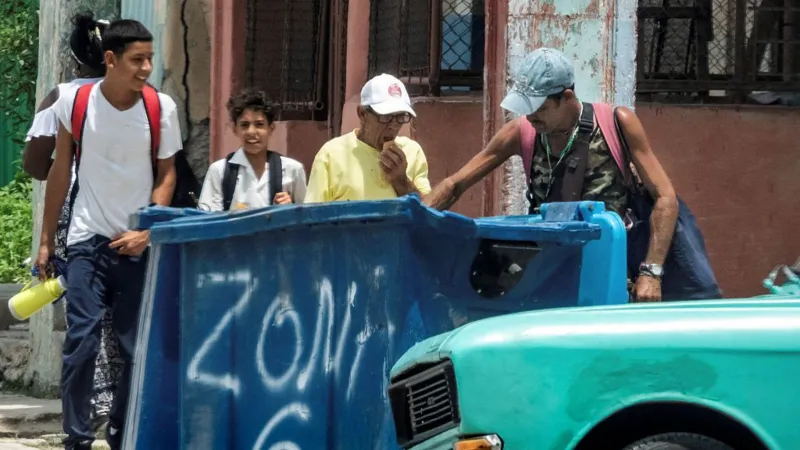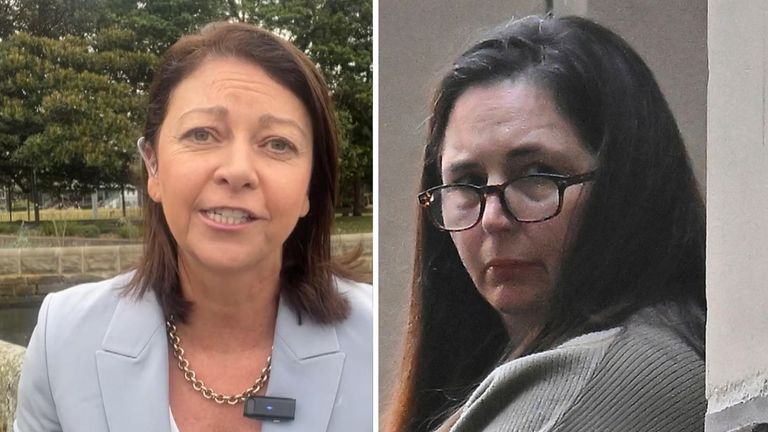V&A East's plans to shake up the art world with community-inspired museum and storehouse
Gus Casely-Hayford is a man on a mission to open up and diversify the arts sector.

As founding director of V&A East - one of the world's most significant new museum projects and part of the mayor of London's £1.1bn Olympic legacy project - he knows that shifting the canon won't necessarily be easy.
Casely-Hayford told Sky News: "There are challenges that we have in this country… Years of museum tradition based around particular narratives.
"There's a fairly conservative bedrock upon which we have to begin to build new narratives. Think about how we can actually include voices that it may have felt acceptable to marginalise a generation ago."
Based in Stratford's Queen Elizabeth Olympic Park, V&A East will bring two brand new arts venues to East London - a five-storey, 7,000 square meter museum on the waterfront, and a vast glass and brick storehouse, offering more than 250,000 curated items for public view, just a 10-minute walk away.
Balenciaga inspired
Based on an X-Ray of a Balenciaga ballgown, and informally dubbed "the crab", the museum will form part of a new cultural quarter collectively known as East Bank, nestling alongside a Sadler's Wells dance theatre, BBC recording and performance studios and UAL's London College of Fashion.
Cal Kestis, played by the TV actor Cameron Monaghan, in Star Wars Jedi: Survivor
Star Wars Jedi: Survivor star Cameron Monaghan tips more film and TV actors to follow him into 'really exciting' gaming roles
In a world where many consider the arts to be for the privileged few rather than the many, Casely-Hayford says his bid to highlight under-represented voices is clear cut.
He said: "These are our spaces paid for with our tax money. We should all be getting the benefit."
He said: "Art is one of the things that we do better than anyone else. You look at the sorts of people who represent us best at the Oscars or in music, and they represent the cultural diversity of our nation.
"I would love it if in the museum sector, if we could really get on board with that, invest in that, but not just do it in terms of the art that we display on our walls, but also the people who curate our spaces."
The Global South
The museum will collect work from around the world, prioritising issues from the Global South - Latin America, Asia, Africa, and Oceania.
And far from being a modern obsession or trendy buzzword, Casely-Hayford believes diversity is woven into the very fabric of being British.
He said: "The thing that makes me proud is that we are a diverse nation. You think about our national flag, that we didn't choose a tricolour.
"We chose a flag which demonstrates the differences and how we come together, that we are a number of different nations. We accept diversity, complexity, and we want our space to be able to tell those stories.
"All of that cultural complexity, the stories of empire, of enslavement, of all these difficult things. But also, the transcendent stories of how through creativity, we can come together as one.
"We can be a single nation that celebrates greatness, goodness, that celebrates the sorts of things that inspire a new generation."
'An engine of transformation'
And he says aside from artists and curator diversity, attention must be turned to both the visitors and staff of the museum too.
"We want to build this institution from the ground up, for and with our local communities. We want it to reflect their need," he said.
"When it opens in 2025 and you come into our space, I'm hoping that you'll be welcomed by people who demonstrate the kind of cultural complexity of the people that live in and around this area."
Not a man to rest on his laurels, he's quite literally got on his bike to share news of the new spaces to secondary schools in the area, in a bid to talk to 100,000 young people.
It is his ambition that one of the children who walks through the museum doors will go on to have their art on the walls, or even one day claim his job.
Calling the spaces "an engine of transformation", he wants the younger generation to see the creative industries as a viable profession, as he says, "not from the margins, not feeling they're part of the peripheral, but right in the bedrock of institutions like V&A East".
Holding institutions to account
Ahead of these potential new opportunities, emerging artist Heather Agyepong says the last two years have been transformational in black British art, offering her a position of power as an artist for the first time.
She told Sky News: "I think since George Floyd was murdered, and the black uprisings, there's been a real thirst and a kind of embarrassment about the lack of black British art in collections.
"In 2020, all of these institutions gave these massive pleas and dedications to include more black British art, which has been amazing. But I think now, two years on, you're seeing that some of it was a little bit performative, or for optics.
"For me as an artist now, I feel I can hold those intuitions accountable because they made all of these claims, and I can go back and say, 'what are you doing to address your collections? What are you doing to address the inclusion of black British art?'
"I feel quite empowered now, as an artist moving forward."
However, she admits she wasn't always as clued up about the rich heritage of the UK's black artists.
She said: "I did an MA at Goldsmiths in 2013, and that was my first introduction to black British art, before then, I think I didn't even know black British artists existed, if I'm honest.
"My course convenor, Paul Halliday, opened my eyes to what that whole movement looked like. And I remember, I was just stunned, and I felt like, 'why did no one tell me this?', because I always felt I was by myself. So, that course was really instrumental in understanding the legacy of us as artists."
'Small and in the corner'
Speaking about her latest exhibition, Ego Death, which includes oversized fabric triptychs, one inspired by Oscar winning film Get Out, she says: "There's a thing sometimes about black artists, we feel like we can't take up space, that we've kind of got to be small and in the corner. Be kind of apologetic."
She credits artists including Turner Prize winning Lubaina Himid, Sonya Boyce and Claudette Johnson - who all came to prominence during the UK Black Arts movement (BAM) of the 1980s - as "paving the way" for her, adding: "I wouldn't be here without them."
-sky news






